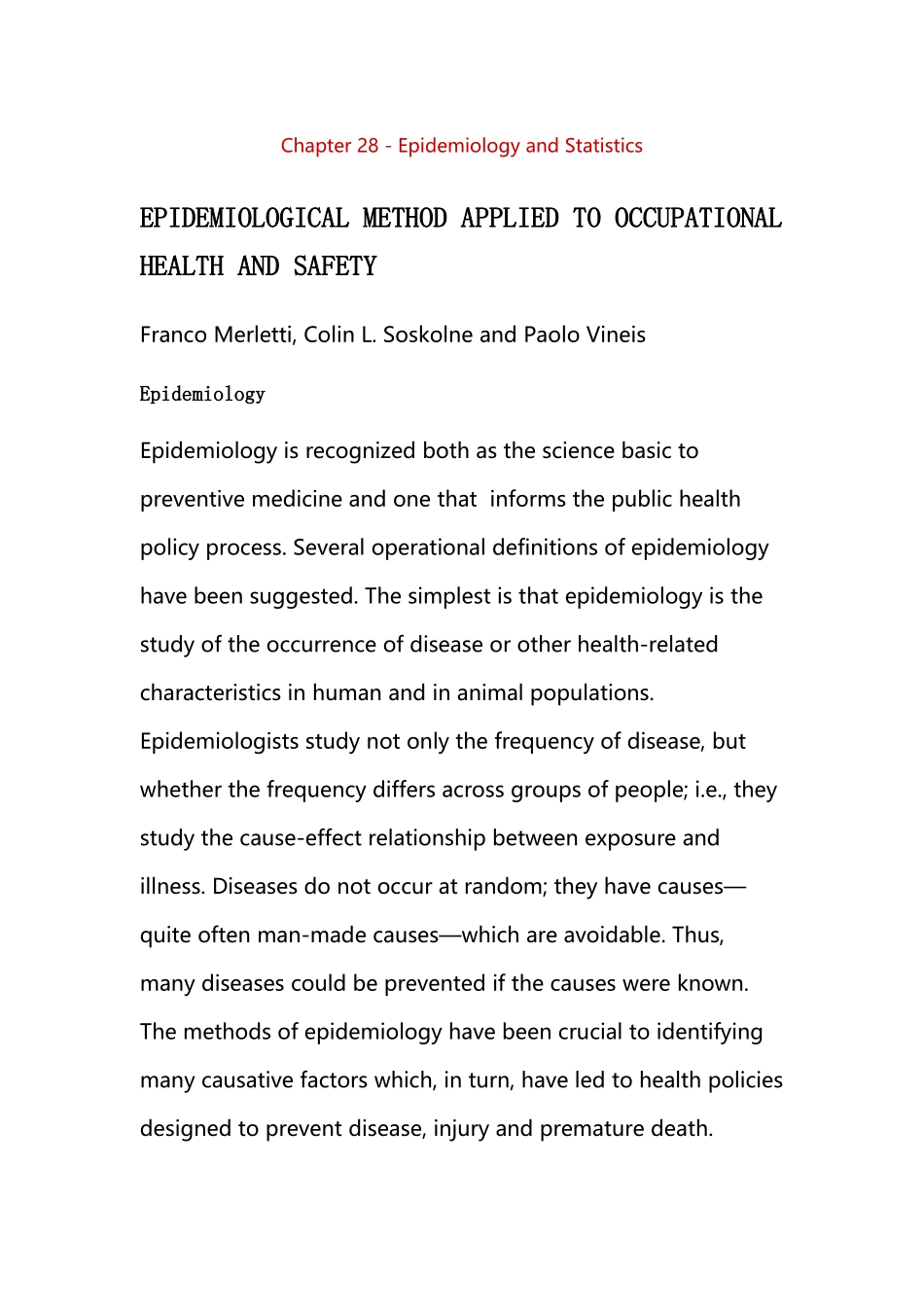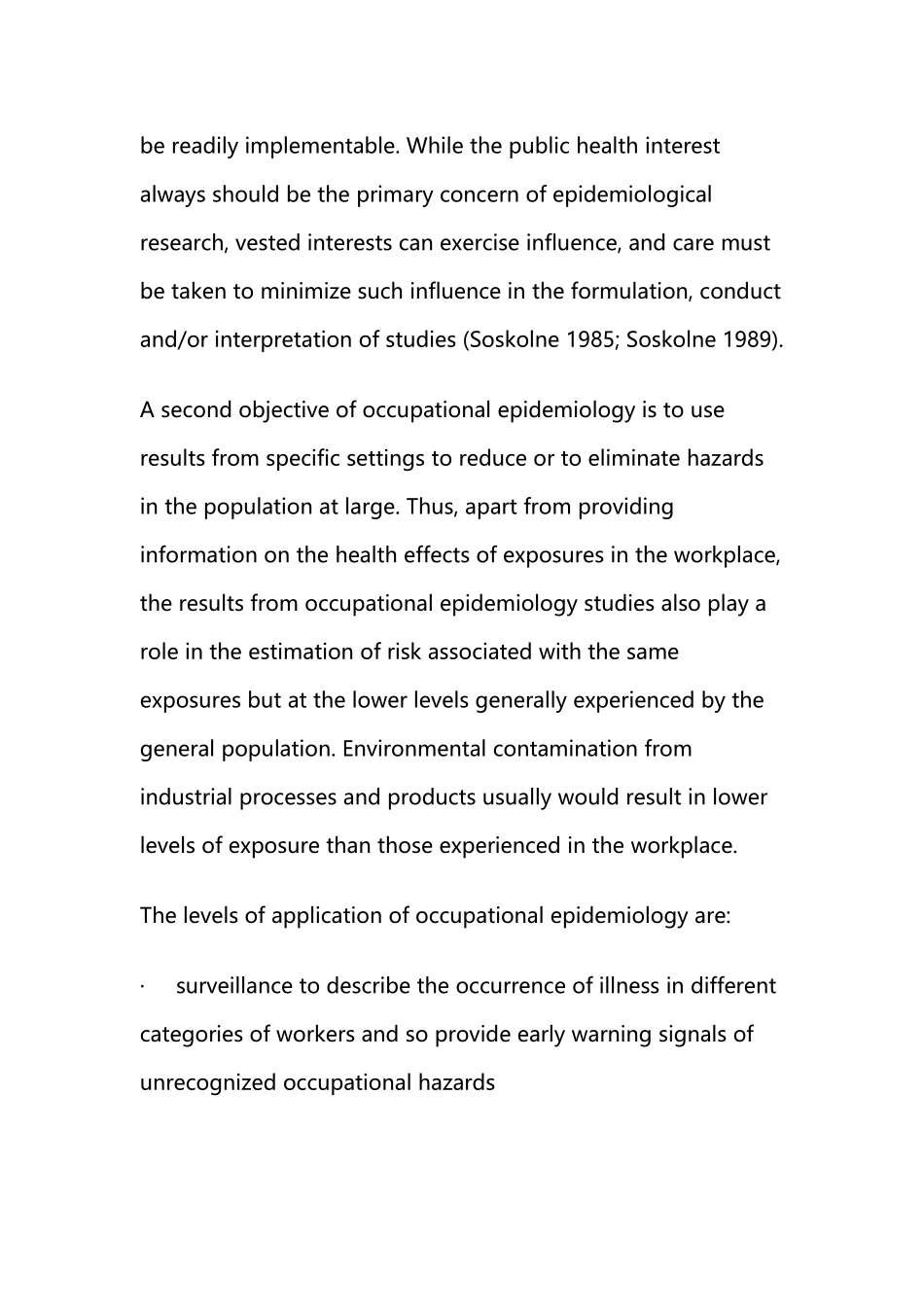Chapter28-EpidemiologyandStatisticsEPIDEMIOLOGICALMETHODAPPLIEDTOOCCUPATIONALHEALTHANDSAFETYFrancoMerletti,ColinL.SoskolneandPaoloVineisEpidemiologyEpidemiologyisrecognizedbothasthesciencebasictopreventivemedicineandonethatinformsthepublichealthpolicyprocess.Severaloperationaldefinitionsofepidemiologyhavebeensuggested.Thesimplestisthatepidemiologyisthestudyoftheoccurrenceofdiseaseorotherhealth-relatedcharacteristicsinhumanandinanimalpopulations.Epidemiologistsstudynotonlythefrequencyofdisease,butwhetherthefrequencydiffersacrossgroupsofpeople;i.e.,theystudythecause-effectrelationshipbetweenexposureandillness.Diseasesdonotoccuratrandom;theyhavecauses—quiteoftenman-madecauses—whichareavoidable.Thus,manydiseasescouldbepreventedifthecauseswereknown.Themethodsofepidemiologyhavebeencrucialtoidentifyingmanycausativefactorswhich,inturn,haveledtohealthpoliciesdesignedtopreventdisease,injuryandprematuredeath.Whatisthetaskofepidemiologyandwhatareitsstrengthsandweaknesseswhendefinitionsandconceptsofepidemiologyareappliedtooccupationalhealth?Thischapteraddressesthesequestionsandthewaysinwhichoccupationalhealthhazardscanbeinvestigatedusingepidemiologicaltechniques.Thisarticleintroducestheideasfoundinsuccessivearticlesinthischapter.OccupationalEpidemiologyOccupationalepidemiologyhasbeendefinedasthestudyoftheeffectsofworkplaceexposuresonthefrequencyanddistributionofdiseasesandinjuriesinthepopulation.Thusitisanexposure-orienteddisciplinewithlinkstobothepidemiologyandoccupationalhealth(Checkowayetal.1989).Assuch,itusesmethodssimilartothoseemployedbyepidemiologyingeneral.Themainobjectiveofoccupationalepidemiologyispreventionthroughidentifyingtheconsequencesofworkplaceexposuresonhealth.Thisunderscoresthepreventivefocusofoccupationalepidemiology.Indeed,allresearchinthefieldofoccupationalhealthandsafetyshouldservepreventivepurposes.Hence,epidemiologicalknowledgecanandshouldbereadilyimplementable.Whilethepublichealthinterestalwaysshouldbetheprimaryconcernofepidemiologicalresearch,vestedinterestscanexerciseinfluence,andcaremustbetakentominimizesuchinfluenceintheformulation,conductand/orinterpretationofstudies(Soskolne1985;Soskolne1989).Asecondobjectiveofoccupationalepidemiologyistouseresultsfromspecificsettingstoreduceortoeliminatehazardsinthepopulationatlarge.Thus,apartfromprovidinginformationonthehealtheffectsofexposuresintheworkplace,theresultsfromoccupationalepidemiologystudiesalsoplayaroleintheestimationofriskassociatedwiththesameexposuresbutatthelowerlevelsgenerallyexperiencedbythegeneralpopulation.Environmentalcontaminationfromindustrialprocessesandproductsusuallywouldresultinlowerlevelsofexposurethanthoseexperiencedintheworkplace.Thelevelsofapplicationofoccupationalepidemiologyare:·surveillancetodescribetheoccurrenceofillnessindifferentcategoriesofworkersandsoprovideearlywarningsignalsofunrecognizedoccupationalhazards·generationandtestingofanhypothesisthatagivenexposuremaybeharmful,andthequantificationofaneffect·evaluationofanintervention(forexample,apreventiveactionsuchasreductioninexposurelevels)bymeasuringchangesinthehealthstatusofapopulationovertime.Thecausalrolethatoccupationalexposurescanplayinthedevelopmentofdisease,injuryandprematuredeathhadbeenidentifiedlongagoandispartofthehistoryofepidemiology.ReferencehastobemadetoBernardinoRamazzini,founderofoccupationalmedicineandoneo...



 优质VIP
优质VIP 优质VIP
优质VIP 优质VIP
优质VIP 优质VIP
优质VIP 优质VIP
优质VIP 优质VIP
优质VIP 优质VIP
优质VIP 优质VIP
优质VIP 优质VIP
优质VIP 优质VIP
优质VIP